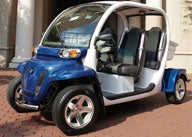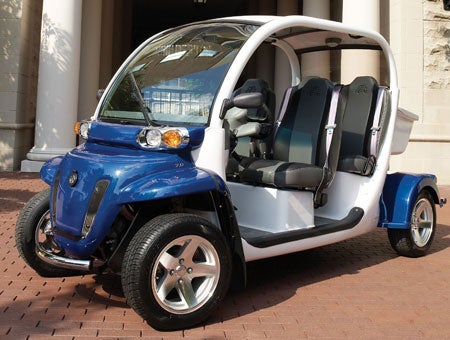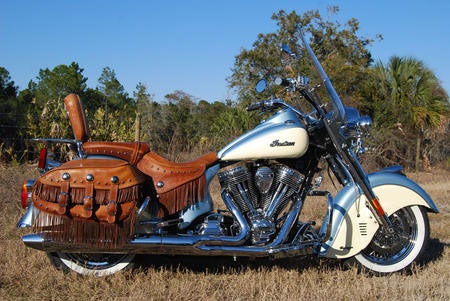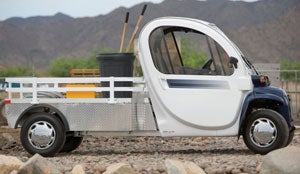A New Polaris in the Making?

Will two recent acquisitions change Polaris as a company?
It’s not exactly the fall of the Berlin Wall, but we’re thinking that two recent Polaris announcements may prove to be beginning of an entirely new Polaris. So, mark down April 2011 as the time Polaris changed.
We’ve written two books about Polaris’ history — from the 1940s beginning as Hetteen Hoist & Derrick, through the 1960s sale to multi-national Textron, then back to the 1980s entrepreneurial independence and up to the company’s emergence as an ATV manufacturer. Maybe we are a bit overly sensitive to the company’s goings-on, but we think not. We’ve been observing Polaris from the sidelines for a long time and we’ve never seen the company hold such a position as it does now.
 Global Electric Motorcars offers two-seat people movers. (Image courtesy of GEM.)
Global Electric Motorcars offers two-seat people movers. (Image courtesy of GEM.)Considering that Polaris Industries started up in the mid 1950s and has emerged as a current Wall Street favorite for how it runs its business, you’d think that the Minnesota-based company would have been involved with mergers and acquisitions much more prominently than it is now. In the span of about a week in late April, Polaris announced the purchase of Indian Motorcycles and the acquisition of Global Electric Motorcars from Chrysler. It’s nice to have a very good first quarter kicking off 2011 and it’s nice to have cash to make such deals.
 With Polaris entering an electrifying portion of its corporate history, will there be an electric sled in your future?
With Polaris entering an electrifying portion of its corporate history, will there be an electric sled in your future?Times haven’t always been kind to Polaris. The initial growth from 1945 to 1968 was troubled. Snowmobiles became the go-to product after Hetteen Hoist & Derrick changed its name to Polaris Industries in the mid-1950s. With snowmobiles looking like the 1960s version of the “dot.com” era, Polaris became part of a multinational conglomerate, which held on until 1981, when a core group of Textron/Polaris managers led by Hall Wendel bought the company. Many of those executives mortgaged their homes to make their investment in a company that Textron was prepared to eliminate. The good and bad of the time was simple. The economic climate and snowmobile business were both poor, which was good for Polaris as there was really only an upside if they could hang on. They did.
Shortly after the “new” Polaris got started, the company tried its hand at acquisitions, purchasing a paint spray operation that went nowhere. It was a lesson that kept Polaris executives from getting overly aggressive during much of the Hall Wendel years.
When Wendel departed and Tom Tiller took over as chief executive, times were good. Polaris snowmobiles had become the top selling sled brand and Polaris ATVs were gaining marketshare. Polaris had established its own Victory brand as a legitimate American-made motorcycle.
In the summer of 2005 Tiller looked to a merger with Austrian motorcycle maker KTM to grow the company through acquisitions. On paper the deal should have worked in Polaris’ favor, but things didn’t work out quite so well as the deal fell apart within a couple of years. KTM managed to get short-term gains to give it impetus to remain independent while Polaris did gather some insight into international mergers. After that exercise, Polaris remained fairly quiet, although it has acquired swissauto Powersports, which has an expertise in designing and developing high performance and efficient engines.
Now, in April 2011, Polaris has made two moves that take the company a bit further from the snowmobile spectrum. Or does it? First Polaris acquired Indian, a legendary motorcycle name but one that has failed to grab much of a niche numbers-wise. Polaris has to be an asset here as it can utilize Victory production and marketing knowledge to streamline Indian manufacturing and branding.
 Polaris’s acquisition of Indian should benefit its own Victory motorcycle line.
Polaris’s acquisition of Indian should benefit its own Victory motorcycle line.The Global Electric Motorcar (GEM) situation seems a bit “iffy” — on the surface. This is a very natural progression and seemingly a great fit for Polaris. Both companies produce Neighborhood Electric Vehicles (NEV) and other electric-powered vehicles. GEM’s line of electric vehicles includes utility “trucks” as well as people movers. Polaris offers its distinct Breeze line of electric vehicles as well as an electric Ranger UTV based version.
When Polaris introduced its line of XP model ATVs, we had a dinner conversation with Polaris engineers discussing the very feasibility of electric motors being used in recreational powersports. Within a year of that conversation Polaris introduced its first electric vehicles. At the time we felt that the engineering department had too good of a grasp for electric power usage in powersports to be a complete coincidence. It was not a coincidence.
 Polaris’s acquisition of GEM provides them with low emission “trucks.” (Image courtesy of GEM.)
Polaris’s acquisition of GEM provides them with low emission “trucks.” (Image courtesy of GEM.)If you’ve followed Polaris outside of its snowmobile biz, you know that Polaris has grown a quite successful government business that includes marketing Polaris electric vehicles to the federal government as well as Polaris engineered combat vehicles to the military.
Electric vehicle maker GEM is based locally — Fargo, North Dakota is across the Red River from Minnesota and just south and west of Roseau, Polaris’ ancestral home. Many of the non-electric pieces of GEM vehicles such as bodywork are similar in concept to Polaris ATVs and snowmobiles. Anyone foresee GEM vehicles outfitted with Polaris’ Lock & Ride luggage?
We have to admit that we find this period very exciting for Polaris, whose chief executive Scott Wine admits that “GEM provides Polaris with an established position in the low-emission small vehicle market and supports Polaris’ strategy of penetrating on-road market segments poised for growth.”
 Joining forces with GEM expands the engineering and marketing for Polaris and its electric-powered Breeze neighborhood vehicles. (Image courtesy of Polaris.)
Joining forces with GEM expands the engineering and marketing for Polaris and its electric-powered Breeze neighborhood vehicles. (Image courtesy of Polaris.)With US gasoline prices poised to hit five bucks a gallon by mid-summer, entry into an alternate fuel market is timely. Even if Polaris doesn’t ever push GEM to become a bigger EV player, the company could readily develop electric technologies that could be applied elsewhere.
In many ways, the current automotive outlook is mindful of the early 1900s as we went from literal horse power to oil power. Now that Polaris is set to be a player in alternate fuel vehicle development maybe it’s not so silly to contemplate changes in our powersports vehicles. After all, the new Chevrolet Volt is an extension of the diesel-electric concept. Instead of using a diesel motor to run a generator to power an electric drive, the Volt uses a traditional four-stroke. And that is an alternative available to Polaris electric ATVs and Rangers — and snowmobiles? It’ll cut emissions, save fuel and electric motors have very good torque.
Who knows? This is all silly speculation but Polaris may prove that its future changed as a company in April of 2011.








 Your Privacy Choices
Your Privacy Choices